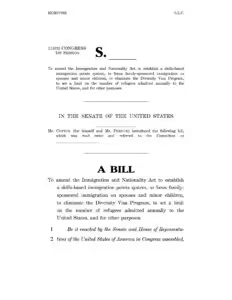Trump's New Immigration Bill: What's The Point?
Last Updated: January 15, 2020

On August 3, 2017 Trump announced his support of S. 1720, a bill introduced by Senator Tom Cotton of Arkansas and co-sponsored by Senator David Perdue of Georgia, two Republicans. Trump said: “This legislation demonstrates our compassion for struggling American families who deserve an immigration system that puts their needs first and puts America first."He called it the “RAISE Act;” short for “Reforming American Immigration for a Strong Economy Act.”The RAISE Act was initially introduced to the Senate back in February and was referred to the Senate Judiciary Committee. It was then revised and reintroduced in August.Trump's adviser Stephen Miller and former adviser Steve Bannon promoted and helped shape the bill.
Many have dismissed this bill because it has not attracted any additional co-sponsors, and Republican leaders in Congress have no plans to vote on it in 2017. However, the bill remains relevant as it gives insight into the thoughts of the President and other leading figures on their ideal immigration system. Additionally, although this bill may not pass, it may influence another bill in the future.Section-by-section, the bill seeks to:
- Section 2: Eliminate the visa diversity lottery program
- Section 3: Enforce the 50,000 annual refugee cap. 84,995 refugees entered the US in 2016.
- Section 4: Narrow the meaning of “immediate relatives”.
- Section 5: Replace the employment-based immigration system with a points-based immigration system
- Section 6: Add one prerequisite for naturalization
These sections altogether would result in around a 30 percent reduction to green cards issued. Let’s take a look at each section in turn.(For more numbers on green cards, take a look at this frequently cited report.
SECTION 1: SHORT TITLE
It states the short title.This Act may be cited as the “Reforming American Immigration for a Strong Economy Act” or the “RAISE Act”.
SECTION 2: ELIMINATES THE DIVERSITY IMMIGRANT VISA PROGRAM
After Section 1, things start to get hairy quick. Section 2 eliminates the diversity visa program.The Diversity Immigrant Visa program, also known as the green card lottery, allows would-be immigrants to receive a United States Permanent Resident Card, or green cards, through a lottery system. This system was established in The Immigration Act of 1990.The lottery provides 50,000 green cards each year and aims to diversify the immigrant population in the United States. To do this it selects applicants from countries with low rates of immigration in the five years prior.Eligibility is determined by the applicant’s birth country, not country of residence. Section 2 eliminates all of that.
“(a) In General.—Section 203 of the Immigration and Nationality Act (8 U.S.C. 1153) is amended by striking subsection (c).”
SECTION 3: REMOVES EXCEPTIONS FOR THE ANNUAL REFUGEE CAP OF 50,000
Section 3 establishes a refugee cap of 50,000 that kind of, debatably, already existed. At the very least, it removes exceptions to the 50,000 rule.This section makes major changes to 8 U.S.C. 1157. 1157 says: the number of refugees who may be admitted may not exceed fifty thousand . . . unless the President determines . . . that admission of a specific number of refugees in excess of such number is justified by humanitarian concerns or is otherwise in the national interest.But that clause apparently only applied to a few years in the early eighties. Ever since then Presidents have been welcoming however many refugees they want.(Take a look here for refugee numbers.)Also, President Trump has tried to cap the refugee intake at 50,000 in various ways already. So again, at the very least, this bill eliminates the options for the President to raise the cap for “grave humanitarian concerns” or the “national interest.” The new code would read:
“(1) IN GENERAL.—The number of refugees who may be admitted under this section in any fiscal year may not exceed 50,000."
Also, an interesting change: special discretionary decision-making power is transferred from the Attorney General to the Secretary of Homeland Security. So the Secretary of Homeland Security would be able to admit any refugee who is not firmly resettled in any foreign country, is determined to be of special humanitarian concern to the United States, and is otherwise admissible as an immigrant.
SECTION 4: LIMITS THE REACH OF FAMILY SPONSORED VISAS
This section primarily narrows the meaning of “immediate relative.” It effectively removes family-visa pathways for siblings and adult children of U.S. citizens and permanent residents to apply for permanent residency status in the U.S. It limits the family path to spouses and minor children.It redefines “immediate relative” as spouse and children under 18 years old. Whereas before it included children up 21, parents, and siblings.
“Family-sponsored immigrants described in this subsection are qualified immigrants who are the spouse or a child of an alien lawfully admitted for permanent residence.”
It allows for 88,000 immigrants minus the number of aliens paroled that did not depart and did not acquire the status of an alien lawfully admitted. It also deals with some rather complicated things like how many of these visas are subject to country limitation and when the visa of a dependent parent can be extended.
SECTION 5: REPLACES THE EMPLOYMENT-BASED IMMIGRATION SYSTEM WITH A POINTS BASED IMMIGRATION SYSTEM
Section 5 establishes a point-system which would replace the employment-based system with the points based system. This is one of the more innovative or creative sections; the system is surprisingly simple. Notably, the caliber of immigrants accepted under the current employment-based system is already remarkably high. So, If the points-based system were implemented then a sufficiently large number of applicants would accrue enough points to maintain a large applicant pool — a large enough pool to keep the number of employment sponsored green cards the same.Raise keeps the current level of employment visas which is 140,000.
“(1) IN GENERAL.—The worldwide level of points-based immigrant visas issued during any fiscal year may not exceed 140,000."
The points system invites any qualifying applicant to apply for submission into the eligible applicant pool. Applicants apply online and pay a $160 fee. An applicant is eligible if they accrue over 30 points. The applicants with the highest point counts are then siphoned off the top every six months until 140,000 people are admitted.Selected applicants are invited to submit another application which would include valid documentation, an attestation from the prospective employer, the annual salary being offered, a declaration that the job position is new or vacant, health insurance records, and a fee of $345.If the applicant is accepted, spouses, minor children, and dependent adult children can also be issued a visa.In regards to the points, the goal is to accrue 30 points. Points are allotted by status in each category.
Would You Qualify for Legal Immigration to the U.S.?
Answer the following questions to find out:
Age:
- 0–17: Ineligible
- 18–21: 6 points
- 22–25: 8 points
- 26–30: 10 points
- 31–35: 8 points
- 36–40: 6 points
- 41–45: 4 points
- 46–50: 2 points
- 51 and older: No points
Education:
Points are awarded only for the highest degree obtained.
- US or foreign high school: 1 point
- Foreign bachelor’s degree: 5 points
- US bachelor’s degree: 6 points
- Foreign master’s degree in STEM: 7 points
- US master’s degree in STEM: 8 points
- Foreign professional degree (including MBA, JD, or MD) or doctorate in Stem: 10 points
- US Professional degree or doctorate in stem: 13 points
English Language Proficiency:
Points are awarded for decile placement in IETSL or TOEFL.
- 1st–5th deciles: 0 points
- 6th–7th deciles: 6 points
- 8th decile: 10 points
- 9th decile: 11 points
- 10th decile: 12 points
Extraordinary achievements
- Nobel Laureate or has received comparable recognition in a field of scientific or social scientific study: 25 points
- Earned an individual Olympic medal or placed first in an international sporting event within the last 8 years: 15 points
- None 0 points
Job Offer
Points are awarded for job offers with high monetary compensation.
- Annual salary 150%–200% of median household income of state: 5 points
- Annual salary 200%–300% of median household income of state: 8 points
- Annual salary 300% and above of median household income of state: 13 points
- No Job Offer 0 points
Investments
- Applicant agrees to invest $1,350,000 in a new commercial enterprise in the US: 6 points
- Applicant agrees to invest $1,800,000 in a new commercial enterprise in the US: 12 points
- No Investment 0 points
Family preference
- The applicant previously qualified for the once valid family preference visa category: 2 points
Requirement
- An applicant is ineligible if he doesn’t have a degree higher than a bachelor’s degree and he is not in the 6th decile or higher for English proficiency.
Spousal consideration
- If an applicant’s spouse would accrue higher points, then no change is made to the applicant’s points. However, if the spouse would accrue lower points, then 70% of the applicant’s points would be added to 30% of the spouse’s points, and this new number would be considered
Minimum Score: 30
You must be at least 18 years old and have at least 30 points to be eligible to apply for immigration, according to proposed legislation.
SECTION 6: CHANGES THE PREREQUISITE FOR NATURALIZATION
Section 6 mostly does some housekeeping to an already standing section of US code. However, at the end, it adds a term that disqualifies from naturalization people who have outstanding debts owed to the federal government.And that’s the RAISE Act explained section-by-section. We’ll see what bill comes next for immigration.
Related
U.S. Immigration News
Articles
Begin Your Immigration Journey Today with SimpleCitizen!
Why spend more time and money on countless legal headaches, when you could just use SimpleCitizen and focus on what matters most – being with those you love! Find new opportunities, start new adventures, and bring your family together with SimpleCitizen today!

